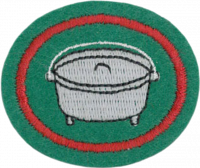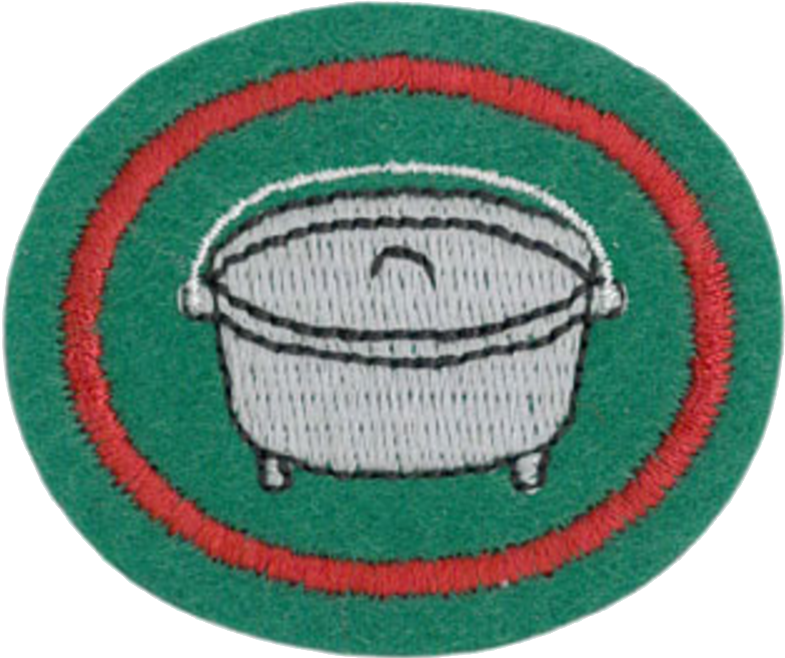Difference between revisions of "AY Honors/Dutch Oven Cooking/Answer Key/es"
From Pathfinder Wiki
< AY Honors | Dutch Oven CookingAY Honors/Dutch Oven Cooking/Answer Key/es
(Created page with "</noinclude> <!-- 6. ¿Qué clase de combustibles se utilizan para cocinar con un horno? --> # Madera # Carbón # Gas natural # Propano # Electricidad") |
|||
| (18 intermediate revisions by 2 users not shown) | |||
| Line 1: | Line 1: | ||
| − | + | {{HonorSubpage}} | |
| − | |||
| − | |||
| − | {{ | ||
| − | |||
| − | |||
| − | |||
| − | |||
| − | |||
| − | |||
| − | |||
| − | }} | ||
| − | |||
| − | |||
| − | |||
| − | |||
| − | < | + | <!--{{Honor Master|honor={{#titleparts:{{PAGENAME}}|1|3}}|master=Wilderness}}--> |
<section begin="Body" /> | <section begin="Body" /> | ||
{{ansreq|page={{#titleparts:{{PAGENAME}}|2|1}}|num=1}} | {{ansreq|page={{#titleparts:{{PAGENAME}}|2|1}}|num=1}} | ||
<noinclude></noinclude> | <noinclude></noinclude> | ||
<!-- 1. Tener las especialidades de Arte culinario y Campamento III. --> | <!-- 1. Tener las especialidades de Arte culinario y Campamento III. --> | ||
| − | {{honor_prerequisite | + | |
| − | {{honor_prerequisite | + | {{honor_prerequisite|honor=Cooking|displayname=Arte culinario}}<br> |
| + | {{honor_prerequisite|honor=Camping Skills III|displayname=Campamento III}} | ||
<noinclude></noinclude> | <noinclude></noinclude> | ||
| Line 32: | Line 18: | ||
{{clear}} | {{clear}} | ||
| − | {{clear}} | + | {{clear}} |
{{clear}} | {{clear}} | ||
| Line 75: | Line 61: | ||
{{ansreq|page={{#titleparts:{{PAGENAME}}|2|1}}|num=7}} | {{ansreq|page={{#titleparts:{{PAGENAME}}|2|1}}|num=7}} | ||
<noinclude></noinclude> | <noinclude></noinclude> | ||
| − | <!-- 7. | + | <!-- 7. ¿Cuáles son las ventajas del carbón como combustible sobre el de madera vegetal? --> |
| − | |||
<noinclude></noinclude> | <noinclude></noinclude> | ||
| Line 82: | Line 67: | ||
{{ansreq|page={{#titleparts:{{PAGENAME}}|2|1}}|num=8}} | {{ansreq|page={{#titleparts:{{PAGENAME}}|2|1}}|num=8}} | ||
<noinclude></noinclude> | <noinclude></noinclude> | ||
| − | <!-- 8. | + | <!-- 8. ¿Cómo controla la temperatura? --> |
| − | |||
{{clear}} | {{clear}} | ||
| Line 93: | Line 77: | ||
{{ansreq|page={{#titleparts:{{PAGENAME}}|2|1}}|num=9}} | {{ansreq|page={{#titleparts:{{PAGENAME}}|2|1}}|num=9}} | ||
<noinclude></noinclude> | <noinclude></noinclude> | ||
| − | <!-- 9. | + | <!-- 9. ¿Qué eficiencia hacen las cenizas al carbón? --> |
| − | |||
<noinclude></noinclude> | <noinclude></noinclude> | ||
| Line 100: | Line 83: | ||
{{ansreq|page={{#titleparts:{{PAGENAME}}|2|1}}|num=10}} | {{ansreq|page={{#titleparts:{{PAGENAME}}|2|1}}|num=10}} | ||
<noinclude></noinclude> | <noinclude></noinclude> | ||
| − | <!-- 10. | + | <!-- 10. Si se usa madera, ¿qué clases son las mejores para cocinar? --> |
| − | |||
<noinclude></noinclude> | <noinclude></noinclude> | ||
| Line 107: | Line 89: | ||
{{ansreq|page={{#titleparts:{{PAGENAME}}|2|1}}|num=11}} | {{ansreq|page={{#titleparts:{{PAGENAME}}|2|1}}|num=11}} | ||
<noinclude></noinclude> | <noinclude></noinclude> | ||
| − | <!-- 11. | + | <!-- 11. Demostrar cómo sazonar correctamente una olla holandesa nueva. --> |
| − | |||
{{clear}} | {{clear}} | ||
| Line 118: | Line 99: | ||
{{ansreq|page={{#titleparts:{{PAGENAME}}|2|1}}|num=12}} | {{ansreq|page={{#titleparts:{{PAGENAME}}|2|1}}|num=12}} | ||
<noinclude></noinclude> | <noinclude></noinclude> | ||
| − | <!-- 12. | + | <!-- 12. Demostrar cómo limpiar correctamente una olla holandesa después de cada uso. --> |
| − | |||
<noinclude></noinclude> | <noinclude></noinclude> | ||
| Line 125: | Line 105: | ||
{{ansreq|page={{#titleparts:{{PAGENAME}}|2|1}}|num=13}} | {{ansreq|page={{#titleparts:{{PAGENAME}}|2|1}}|num=13}} | ||
<noinclude></noinclude> | <noinclude></noinclude> | ||
| − | <!-- 13. | + | <!-- 13. Demostrar la forma adecuada de transportar las ollas holandesas. --> |
| − | |||
<noinclude></noinclude> | <noinclude></noinclude> | ||
| Line 132: | Line 111: | ||
{{ansreq|page={{#titleparts:{{PAGENAME}}|2|1}}|num=14}} | {{ansreq|page={{#titleparts:{{PAGENAME}}|2|1}}|num=14}} | ||
<noinclude></noinclude> | <noinclude></noinclude> | ||
| − | <!-- 14. | + | <!-- 14. Demostrar cómo almacenar correctamente una olla holandesa para un corto plazo y largo plazo. --> |
| − | |||
<noinclude></noinclude> | <noinclude></noinclude> | ||
| Line 139: | Line 117: | ||
{{ansreq|page={{#titleparts:{{PAGENAME}}|2|1}}|num=15}} | {{ansreq|page={{#titleparts:{{PAGENAME}}|2|1}}|num=15}} | ||
<noinclude></noinclude> | <noinclude></noinclude> | ||
| − | <!-- 15. | + | <!-- 15. Cocinar un platillo de cada categoría utilizando una olla holandesa: --> |
| − | |||
<noinclude></noinclude> | <noinclude></noinclude> | ||
{{ansreq|page={{#titleparts:{{PAGENAME}}|2|1}}|num=15a}} | {{ansreq|page={{#titleparts:{{PAGENAME}}|2|1}}|num=15a}} | ||
| Line 147: | Line 124: | ||
{{CloseReq}} <!-- 15a --> | {{CloseReq}} <!-- 15a --> | ||
{{ansreq|page={{#titleparts:{{PAGENAME}}|2|1}}|num=15b}} | {{ansreq|page={{#titleparts:{{PAGENAME}}|2|1}}|num=15b}} | ||
| − | <noinclude></noinclude> | + | <noinclude> |
| + | </noinclude> | ||
<noinclude></noinclude> | <noinclude></noinclude> | ||
| Line 153: | Line 131: | ||
{{ansreq|page={{#titleparts:{{PAGENAME}}|2|1}}|num=15c}} <!--T:27--> | {{ansreq|page={{#titleparts:{{PAGENAME}}|2|1}}|num=15c}} <!--T:27--> | ||
<noinclude></noinclude> | <noinclude></noinclude> | ||
| − | {{: | + | {{:AY Honors/Recipe/Butternut Squash/es}} |
<noinclude></noinclude> | <noinclude></noinclude> | ||
| Line 170: | Line 148: | ||
{{ansreq|page={{#titleparts:{{PAGENAME}}|2|1}}|num=16}} | {{ansreq|page={{#titleparts:{{PAGENAME}}|2|1}}|num=16}} | ||
<noinclude></noinclude> | <noinclude></noinclude> | ||
| − | <!-- 16. | + | <!-- 16. Cocinar con sólo la tapa como una plancha. --> |
| − | |||
<noinclude></noinclude> | <noinclude></noinclude> | ||
| Line 177: | Line 154: | ||
{{ansreq|page={{#titleparts:{{PAGENAME}}|2|1}}|num=17}} | {{ansreq|page={{#titleparts:{{PAGENAME}}|2|1}}|num=17}} | ||
<noinclude></noinclude> | <noinclude></noinclude> | ||
| − | <!-- 17. | + | <!-- 17. Nombrar las seis diferentes formas de cocinar en una olla holandesa. --> |
| − | |||
<noinclude></noinclude> | <noinclude></noinclude> | ||
| Line 184: | Line 160: | ||
{{ansreq|page={{#titleparts:{{PAGENAME}}|2|1}}|num=18}} | {{ansreq|page={{#titleparts:{{PAGENAME}}|2|1}}|num=18}} | ||
<noinclude></noinclude> | <noinclude></noinclude> | ||
| − | <!-- 18. | + | <!-- 18. ¿Qué se entiende por cocinar por montón? --> |
| − | |||
{{clear}} | {{clear}} | ||
| Line 194: | Line 169: | ||
== Referencias == | == Referencias == | ||
<noinclude></noinclude> | <noinclude></noinclude> | ||
| − | + | {{CloseHonorPage}} | |
Latest revision as of 22:58, 17 September 2021
Cocinando en olla holandesa
Nivel de destreza
2
Año
2006
Version
01.04.2025
Autoridad de aprobación
Asociación General
1
Tener las especialidades de Arte culinario y Campamento III.
Para consejos e instrucciones, véase Arte culinario.
Para consejos e instrucciones, véase Campamento III.
2
Decir una breve historia de la olla holandesa y su papel en la historia de Norteamérica.
3
Conocer la diferencia entre un horno de pan, un horno guiso/carne, horno olla/estufa y un horno de campamento.
4
¿De qué manera son los hornos clasificados en medida?
5
Conocer y demostrar la seguridad ante incendios y el manejo seguro del horno holandés y el uso correcto del equipo.
6
¿Qué clase de combustibles se utilizan para cocinar con un horno?
- Madera
- Carbón
- Gas natural
- Propano
- Electricidad
7
¿Cuáles son las ventajas del carbón como combustible sobre el de madera vegetal?
8
¿Cómo controla la temperatura?
9
¿Qué eficiencia hacen las cenizas al carbón?
10
Si se usa madera, ¿qué clases son las mejores para cocinar?
11
Demostrar cómo sazonar correctamente una olla holandesa nueva.
12
Demostrar cómo limpiar correctamente una olla holandesa después de cada uso.
13
Demostrar la forma adecuada de transportar las ollas holandesas.
14
Demostrar cómo almacenar correctamente una olla holandesa para un corto plazo y largo plazo.
15
Cocinar un platillo de cada categoría utilizando una olla holandesa:
16
Cocinar con sólo la tapa como una plancha.
17
Nombrar las seis diferentes formas de cocinar en una olla holandesa.
18
¿Qué se entiende por cocinar por montón?


